Drugs used in the treatment of gout
| Home | | Medicinal Chemistry |Chapter: Medicinal Chemistry : Analgesics, Antipyretics, and NSAIDs
i. Allopurinol (Zyloprim) ii. Probenecid (Benemid) iii. Sulphinpyrazone (Anuturane) - Synthesis and Drug Profile
Drugs used in
the treatment of gout
An acute
attack of gout occurs as a result of anti-inflammatory reaction to crystals of
sodium ureate (the end product of purine metabolism in human beings) that is
deposited in the joint tissues. Drugs used to treat gout may act in the
following ways:
·By inhibiting uric acid synthesis: Allopurinol.
·By increasing uric acid excretion: Probenecid,
Sulphinpyrazone.
·Miscellaneous: Colchicines (alkaloid obtained
from Colchicum autumnale).
i. Allopurinol (Zyloprim)
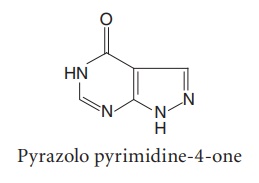
Synthesis
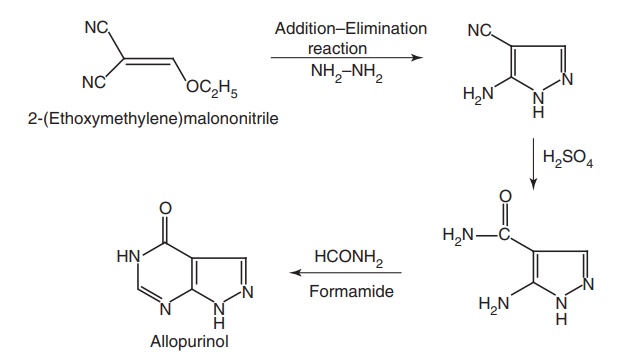
Mode of action: In human beings, uric acid is formed primarily
by the xanthine oxidase-catalyzed oxidation of hypoxanthine and xanthine. At
low concentrations, allopurinol is a substrate for and competitive inhibitor of
the enzyme at high concentrations; it is a noncompetitive inhibitor.

Metabolism: It is rapidly metabolized via oxidation and numerous
ribonucleoside derivatives are formed. The major metabolites are alloxanthine
or oxypurinol.
Properties and uses: Allopurinol is a white powder, very slightly
soluble in water, in alcohol and in dilute solutions of alkali hydroxides. It
is used in the treatment of gout and prevention of urate deposition in patients
with leukaemia receiving anticancer drugs, which cause increasing serum uric
acid levels.
Assay: It is assayed by adopting liquid chromatography technique.
Dose: Usual adult oral dose for gout is 100–200 mg two or three times
a day.
Dosage forms: Allopurinol tablets I.P., B.P.
ii. Probenecid (Benemid)
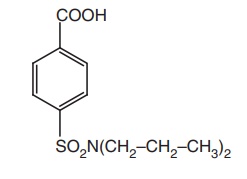
Synthesis

Metabolism: The metabolite is glucuronide conjugates of carboxylic acid, ω
oxidation of N-propyl side chain, and
subsequent oxidation, resulting in alcohol to carboxylic acid derivative. ω
Oxidation of N-propyl side chain and N-dealkylation are the process steps in
the metabolism of probenacid.
Properties and uses: Probenecid exists as white crystalline powder or
small crystals, practically insoluble in water, soluble in acetone, and
sparingly soluble in ethanol. Probenecid is uricosuric agent that increases the
rate of excretion of uric acid and used in the treatment of chronic gout. The
oral administration of probenecid in conjugation with penicillin G results in
higher and prolonged concentration of the antibiotic in the plasma than when
penicillin is given alone.
Assay: Dissolve the sample in alcohol, shaking and heating slightly, if
necessary, and titrate against 0.1 M sodium hydroxide. Determine the end point
potentiometrically.
Dose: Adult oral dose is 500 mg–2 g per day; usually 250 mg two times
a day for one week, then 500 mg twice a day thereafter.
Dosage forms: Probenecid tablets I.P., B.P.
iii. Sulphinpyrazone (Anuturane)
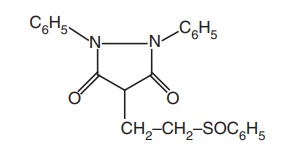
Synthesis
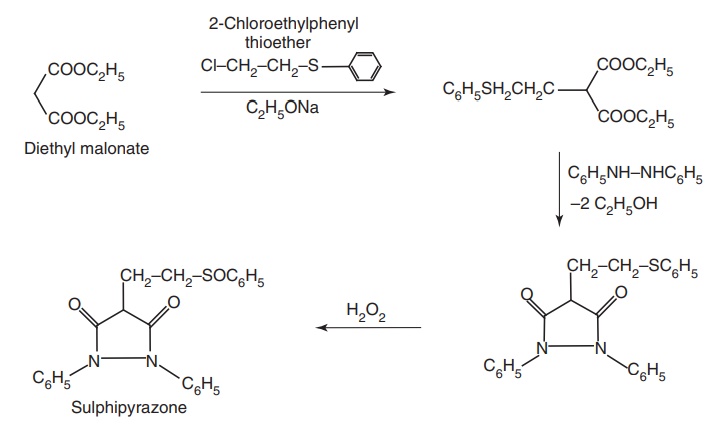
Metabolism: The metabolic product results from sulphoxide reduction,
sulphur, and aromatic oxidation and C-glucuronidation of heterocyclic ring. The
metabolite resulting from para hydroxylation of phenyl ring posseses uricosuric
effect.
Properties and uses: Sulphinpyrazone is a white powder, very slightly
soluble in water, sparingly soluble in alcohol, soluble in dilute solutions of
alkali hydroxides and used as uricosuric agent.
Assay: Dissolve the sample in acetone and titrate against 0.1 M sodium
hydroxide using bromothymol blue as an indicator, until the colour changes from
yellow to blue.
Dose: Initial oral dose is 100–200 mg per day, taken with meals or
milk.
Dosage forms: Sulphinpyrazone tablets B.P.
Related Topics
